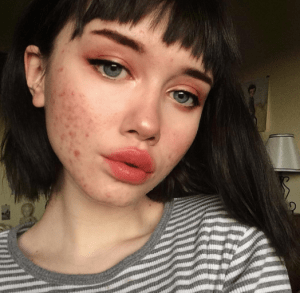Hair follicles beneath the skin become clogged, which leads to acne, a common skin problem. Sebum, an oil that helps prevent skin from drying out, and dead skin cells clog pores, causing lesions to appear and be generally known as pimples or zits. The face is where the outbreaks most frequently appear, although they can also show up on the back, chest, and shoulders.

Acne is an inflammatory condition of the skin that affects the sebaceous (oil) glands that connect to the tiny hair follicles. The pores, which are openings in the follicle, allow the sebaceous glands, which produce sebum, to discharge it onto the skin’s surface in healthy skin. The follicle is lined with skin cells called keratinocytes. The keratinocytes normally shed skin cells as the body does. The keratinocytes normally ascend to the skin’s surface during skin cell shedding. Hair, sebum, and keratinocytes clump together in the pore of an acne patient. As a result, the keratinocytes are kept from shedding and sebum is kept from penetrating the skin’s surface. Inflammation, including swelling, redness, heat, and pain, is brought on by bacteria that ordinarily reside on the skin and can proliferate in clogged follicles when oil and cells are present. Lesions or pimples are produced when the wall of the clogged follicle collapses, spilling germs, skin cells, and oil onto the neighbouring skin.
Most people’s acne usually disappears by the time they reach their thirties, although some people still experience acne in their forties and fifties.
Symptoms
Typical acne
Chronic acne
The severity of your problem will determine your specific acne symptoms.
Whiteheads
Blackheads (open plugged pores)
little, painful, red lumps (papules)
Pus-filled papules, often known as pimples or pustules, are common.
Large, hard, and uncomfortable lumps under the skin (nodules)
pus-filled, agonising tumours under the skin (cystic lesions)
Acne typically develops on the chest, upper back, shoulders, face, and forehead.
Causes
Four main factors cause acne:
Excess oil (sebum) production
Hair follicles clogged by oil and dead skin cells
Bacteria
Inflammation
Because these areas of skin have the most oil (sebaceous) glands, they are where acne often occurs on your face, forehead, chest, upper back, and shoulders. Oil glands are associated to hair follicles.
A whitehead may develop if the follicular wall enlarges. Alternatively, a blackhead could form if the plug is exposed to the surface and darkens. A blackhead may appear to have dirt lodged in the pore. However, the pore is actually clogged with germs and oil, which when exposed to air turns brown.
When clogged hair follicles swell up or get infected with germs, pimples appear as elevated red spots with a white centre. Cyst-like lumps appear beneath the surface of your skin as a result of obstructions and inflammation deep inside hair follicles.
Acne can be aggravated or caused by certain factors:
Hormonal adjustments. In both boys and girls, androgens are hormones that rise during puberty and induce the sebaceous glands to grow and produce more sebum. Breakouts can also result from hormonal changes around midlife, particularly in women.
Certain medicines. Examples include corticosteroid, testosterone, and lithium-containing medications.
Diet. According to studies, eating certain foods, such as carbohydrate-rich foods like bread, bagels, and chips, may make acne worse. If adhering to particular dietary limitations will help persons with acne, more research is required.
Stress. Although stress doesn’t cause acne, it can exacerbate an existing case if you already have acne.
Myths about acne
These elements barely impact acne:
Fatty foods and chocolate. Eating greasy food or chocolate has very little to no impact on acne.
Hygiene. Skin that isn’t clean doesn’t get acne. In actuality, overly vigorous skin cleansing with abrasive soaps or chemicals can aggravate acne by irritating the skin.
Cosmetics. Cosmetics don’t always make acne worse, especially if you use noncomedogenic (oil-free) makeup and take it off frequently. Fortunately, cosmetics don’t affect how well acne medications work.
risk elements
Acne risk factors include:
Age. Acne can affect anyone of any age, although teenagers are the most likely to get it.
Hormonal adjustments. These alterations frequently occur during puberty or pregnancy.
Family background. Acne is genetically influenced. If both of your parents have acne, there’s a good chance that you will too.
Oily or greasy substances. Wherever your skin comes into contact with oil or greasy lotions and creams, you run the risk of developing acne.
Pressure or friction against your skin. Items like phones, cell phones, helmets, tight collars, and backpacks can all contribute to this.



